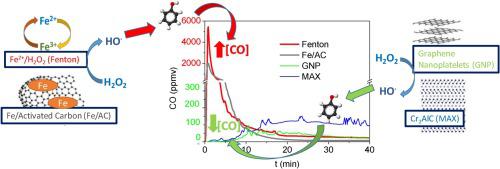Catalysis Today ( IF 5.3 ) Pub Date : 2019-12-16 , DOI: 10.1016/j.cattod.2019.12.020 J. Carbajo , A. Quintanilla , A.L. Garcia-Costa , J. González-Julián , M. Belmonte , P. Miranzo , M.I. Osendi , J.A. Casas

|
Herein, the formation of carbon monoxide as a harmful product upon the Catalytic Wet Peroxide Oxidation process is studied in presence of different solid catalysts: an iron supported activated carbon catalyst, a metal-free catalyst based on Graphene Nanoplatelets, and 1.6 wt.% Fe containing Cr2AlC MAX phase catalyst. The CWPO performance and the evolution of the gas effluent have been compared to that obtained in a conventional Fenton process.
Carbon monoxide yield released was significantly lower in Catalytic Wet Peroxide Oxidation process in relation to that obtained in the Fenton process, where CO concentration reaches a maximum of 6651 mg/Nm3. By contrast, in presence of activated carbon-Fe catalyst and, notably, Graphene Nanoplatelets and Cr2AlC MAX phase catalysts, a more progressive phenol and aromatics intermediates oxidation resulted in a much lower CO maximum concentration in the gas phase at the exit of the reactor of 2454 mg/Nm3, 170 mg/Nm3 and 187 mg/Nm3, respectively.
Hence, when compared to the homogeneous Fenton oxidation, Catalytic Wet Peroxide Oxidation process results be a more sustainable treatment for high-loaded phenolic wastewaters by decreasing the hazardous CO gaseous emissions avoiding this way a secondary pollution during the oxidation process.
中文翻译:

催化湿式过氧化物氧化过程中催化剂对一氧化碳形成的影响
在本文中,研究了在不同的固体催化剂存在下催化湿式过氧化物氧化过程中一氧化碳作为有害产物的形成:铁负载活性炭催化剂,基于石墨烯纳米片的无金属催化剂和1.6 wt%的铁含有Cr 2 AlC MAX相催化剂。已将CWPO性能和废气排放量与常规Fenton工艺所获得的性能进行了比较。
Carbon monoxide yield released was significantly lower in Catalytic Wet Peroxide Oxidation process in relation to that obtained in the Fenton process, where CO concentration reaches a maximum of 6651 mg/Nm3. By contrast, in presence of activated carbon-Fe catalyst and, notably, Graphene Nanoplatelets and Cr2AlC MAX phase catalysts, a more progressive phenol and aromatics intermediates oxidation resulted in a much lower CO maximum concentration in the gas phase at the exit of the reactor of 2454 mg/Nm3, 170 mg/Nm3 and 187 mg/Nm3, respectively.
因此,与均相的Fenton氧化相比,通过减少有害的CO气体排放,避免了氧化过程中的二次污染,催化湿式过氧化物氧化工艺可对高负荷酚类废水进行更可持续的处理。



























 京公网安备 11010802027423号
京公网安备 11010802027423号